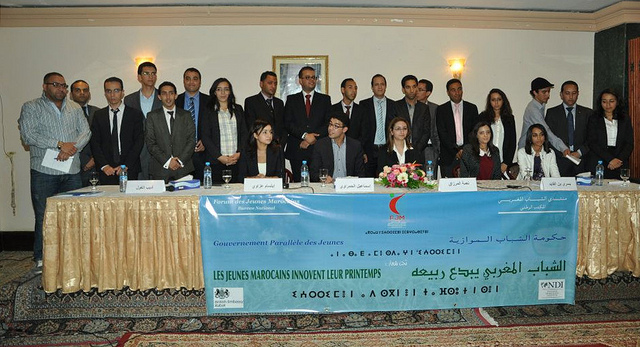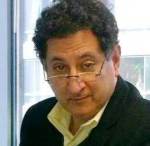Updated
Morocco’s Dilemma: How to Achieve Sustained, Inclusive Growth and Overcome Social and Economic Inequality – Jean R. AbiNader

Morocco’s Parallel Youth Government says it hopes to tackle corruption while creating a platform for young people to take part in politics Photo: Magharebia
Jean R. AbiNader
October 9, 2018

Jean R. AbiNader, Moroccan American Center
Morocco faces a dilemma common to many countries in Africa and the Middle East: given limited resources and large youth population, how does it overcome structural barriers to balanced and equitable economic growth and still achieve political openness?
This is a critical problem for Morocco because it is in a democratic process towards greater government power-sharing that should be empowering citizens and local officials. Yet, as Moroccans become more immersed in the country’s promised political openness, they don’t feel that their quality of life has improved, and may in fact have declined. This is equally true in Tunisia as well where after impressive strides in moving towards more democratic governance, the lack of equitable economic growth and setbacks in political reform are paralyzing its forward progress.
What makes Morocco unique is the role of King Mohammed VI, who regularly calls for greater reforms, more transparency, and economic development. Yet despite some firings of government officials, large allocations for development projects in many underserved parts of the country, and the laudable results of government programs such as the National Initiative for Human Development (INDH), there are still high barriers to achieving needed economic and social outcomes.
I believe the king recognizes that Morocco cannot follow the Singapore model of growth where a strong leader achieves economic progress while limiting political freedoms. His instincts seem to incline him towards evolving a constitutional democracy. Yet the royal palace and successive governments have not adopted long-term strategies that blend development and security concerns. There are too many structural constraints such as corruption, a lack of transparency in policy making, favoritism, inefficiencies in the bureaucracies, and a weak political party system. With the rise of communications technology, ease of mobilizing concerned citizens around issues critical of government policies, and the ability of “the street” to attract international attention, Moroccan expectations are rising.
Two recent reports highlight the challenges in moving forward to achieve both growth and stability. The OECD, in conjunction with the African Union’s Department of Economic Affairs, published a report this summer which detailed the challenges facing Morocco. The report focused on the country’s economic growth, job opportunities, and social inequalities.
According to a summary provided by Morocco World News, “Findings indicate that Morocco’s commendable socio-political reforms are still tainted by ‘alarming social inequalities’ and an increasing income inequality gap.” On the other hand, Morocco stands out because of its stability, which reflects the bond between the people and the king, an asset being eroded by the increasing reliance on the security services to maintain order.
While Morocco has made significant strides in social housing, local and national infrastructure, decreasing its overall level of poverty, and meeting its Millennium Development Goals, it still lags behind other North Africa countries. The Gini Coefficient that measure inequality between the highest and lowest socio-economic indicators ranks Morocco at 40.3%, Algeria 23%, Egypt 30.8%, and Tunisia at 35.8%.
The study also examined actions governments have taken to reduce poverty through access to social services, education, healthcare, electricity, and clean water. “According to the report, all the indicators point that Morocco is outperformed by other countries in the region.”
Looking at the labor market showed that “the informal sector represents 11 to 33 percent of Morocco’s per capita GDP and 60 percent of Moroccans work in that sector.” Wages are not adequate to sustain a healthy quality of life in the urban areas, and there is a continuing lack of opportunities for most skilled workers and young university graduates.
CESE sees the problems, offers solutions
The other major report on Morocco’s social equality was produced by the Economic, Social, and Environment Council (CESE). In its annual report, the CESE, which is a constitutionally mandated advisory agency, reported on “the persistence of dysfunctions that undermine efforts to revive Morocco’s economic momentum and boost social protection at a time the country is seeing a resurgence in clandestine migration among its citizens,” according to a story in Arab Weekly.
Noting the OECD report, the CESE said that economic inequalities were greater than the average of those in comparable countries. “The social movements observed in our country during the recent period show that poverty, youth unemployment and inequalities are less and less accepted,” it said.
Given the lack of effective responses to ongoing demonstrations in the north and northeast of Morocco, the report said that the government is not doing enough and “called for boosting social justice, accountability, good governance, and the fight against corruption and all forms of abuse.” It also warned about inaction. “Moroccan society has changed and intolerance towards inequalities is becoming increasingly high, citizens being more aware of their rights and expressing more dissatisfaction, needs and expectations,” said the report.
With young people and many in the middle class participating in demonstrations and boycotts, the report noted that “young people were particularly intolerant of inequalities as they increasingly vent their anger in the virtual world, including social networks.” As the protestors concerns are not addressed, their options are not constructive: drugs, violence, emigration, and petty crime are among their choices, none of which help the country.
While the country continues to create about 87,000 jobs annually, there is a mismatch between education and market needs, a continuing challenge that Morocco seeks to address through an integrated strategy bringing together vocational, technical, university, and secondary school curricula and training focused on jobs and careers. As the article mentioned, “Youth unemployment continues to haunt the Islamist-led government. The unemployment rate among young Moroccans is 2.6 times higher than the national average despite the various integration programs.” While several reforms to encourage economic growth have been enacted, their implementation is lagging. “The CESE also cited corruption, lack of efficiency of the administration, and difficulties of access to financing continuing to hamper the business environment in Morocco.”
There is general agreement that the government needs to reform its fiscal policies, promote entrepreneurship, and support the growth of small and medium-sized enterprises by developing a more flexible business environment that enables and empowers growth.
Another article on the CESE report, published in Morocco World News, noted that Moroccans are increasingly feeling that “The social movements recorded during the recent period have shown that poverty, youth unemployment, exclusion, and inequalities are increasingly experienced as injustices by the population.”
According to the article, “The report stated that inequalities still have significant impact on the country’s social cohesion. The words “inequalities” and “disparities” appeared more than 130 times in CESE’s 190-page report.” Among other factors “The report also mentioned discriminatory and unjust behaviors such as corruption and nepotism as contributors to a system where merit is less important, and to young people’s lack of confidence in the labor market.”
The statistics are challenging. “According to the report, upward social mobility is attained by more men than women (43.7% to 17.9%) as well as urban dwellers than rural people (51.1% to 14.8%). On the other hand, downward mobility concerned more women (61%) than men (24.1%), and rural women (44%) compared to urban women (19.3%).”
CESE listed nine distinct reforms that should be enacted to move forward, including “the strengthening of social justice, accountability, good governance, the fight against corruption and all forms of abuse, should be put in parallel with an in-depth action to redress existing economic, social, and regional inequalities.” The drive to reduce inequality will be greatly abetted by this report.